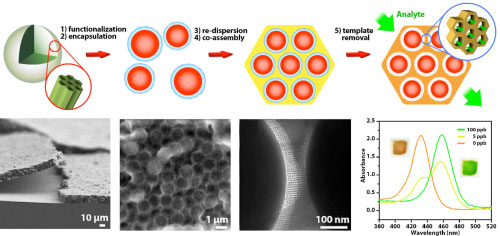|
06/15/2010
Turning Functional Colloids into Materials
Recent research from the research group of Professor Andreas Stein.
In recent years,
many synthetic methods have been developed to prepare nanoparticles and colloids
that can perform specific functions, such as sensing or catalysis, when they
interact with other molecules. However, recovery and recycling of such small
particles can be difficult and their effects on health are often not well
understood. In a recent paper published in Chemistry of Materials, 2010, 22,
3790, graduate student Fan Li (who is now at Dupont Central Research & Development)
and Professor Andreas Stein describe an approach of embedding functional
colloids in a thin film matrix, while keeping active sites on these particles
accessible to other molecules. The thin films combine the properties of the
colloids with a macroscopic material that can be easily handled and does
not release the colloids into the environment.
Mesoporous silica
spheres decorated with organic probe molecules for visual cadmium ion detection
were coated with a thin protecting polymer layer to form core/shell particles.
When these particles were redispersed in a mixture of a silica precursor,
surfactant and hydrochloric acid, composite films with hierarchical pore
structure could be prepared by spin-coating. The polymer capsule protected
the mesoporous silica spheres from being exposed to the silica precursor
in the assembly step, which could have blocked the mesopores. Once the polymer
and surfactant components were removed by extraction, composite porous structures
were derived in which the mesoporous silica spheres were surrounded by a
skeleton of another mesoporous silica phase. An observed color change of
the film after exposure to analyte solutions with parts-per-billion concentrations
of cadmium ions confirmed that the probe molecules remained active after
the multiple processing steps and that they were accessible via the mesopores
in the silica matrix surrounding the embedded spheres. By separating the
sphere synthesis and functionalization steps from the film casting step,
it is possible, in principle, to embed multiple sets of mesoporous spheres
with different functional groups, whose syntheses may not be compatible with
each other. The figure below shows a schematic of the membrane fabrication
process on the top and microscopy images of the film, the colloidal array
in the film, the mesoporous walls that permit molecule access to the colloids,
and data showing the color change of the material after exposure to cadmium
ions (bottom, from left to right).

|